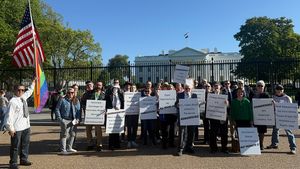(CNN) — With the third anniversary of the Covid-19 outbreak, the secondary pandemic of hunger still looms for many Americans. According to the US Department of Agriculture (USDA) Economic Research Service, nearly 34 million people in the US live in food-insecure households.
It's a figure that just scratches the surface according to Claire Babineaux-Fontenot, CEO of food bank network Feeding America. "The nuance is that some people are not 'food insecure' because they get access to the charitable food system. That doesn't mean they're able to achieve self sufficiency." According to Feeding America, in 2020, as the pandemic took root, 60 million people — almost 1 in 6 Americans — turned to the charitable food system for help.
With the recent end of SNAP emergency allotments, rising food costs and a potential recession, the situation could get worse.
Charitable food organizations foresee another demanding year ahead
"Every single county, parish in the whole United States has its own challenges with food insecurity," Babineaux-Fontenot says, but points out that communities of color are particularly suffering. Feeding America reports 1 in 5 Black and Native Americans are food insecure.
Since Emergency SNAP Allotments expired, the rural South has been hard-hit.
Allotments expired in May of 2022 for Georgia residents and Babineaux-Fontenot says her network of food banks are already seeing the impact.
"The Atlanta Community Food Bank has reported a 40 percent increase in demand since additional benefits have expired."
Feeding America is straining to keep up.
"We have fewer donations, federal commodities have been significantly reduced and we have less money all across our network, while we're seeing fewer and fewer donations from the public all at a time when people are still in need of help."
Covid inspired creation of a metro-Detroit food pantry. Demand never let up
"The line was even longer yesterday," said Tarence Wheeler, Director of Community Affairs at the River Rouge School District, the day after SNAP emergency allotments ended. The district sits about ten miles outside Detroit.
"It's the working poor, the person that makes too much money to get help, but not enough to survive."
The district partnered with local food rescue non-profit Forgotten Harvest to start a mobile food drive, where every Wednesday, anyone can pick up groceries, no questions asked.
The idea for the food drive came when in-person classes were initially suspended for Covid in the spring of 2020. Wheeler and the district's superintendent, Dr. Derrick Coleman, began delivering meals to some of the students' homes for what they called "We Love You Fridays" in hopes of keeping students engaged with the district. Amid those deliveries, they learned something disheartening: many of the students they were delivering meals to had entire families who didn't have enough food to eat.
"I said 'we need to do more'," he explained in an interview with CNN.
Now, every Wednesday morning, whether it rains, shines, or snows, Wheeler and his army of volunteers gather at Ann Visger Preparatory Academy to put food in the hands of those who need it. Wheeler says, on average, about 300 cars line up by 5 AM to collect goods from the pantry each week. People come from as far as Toledo, Ohio, and those without transportation show up with wagons, suitcases, laundry carts, and even wheelchairs to fill with groceries for the week.
"Our job is to empty these pallets with zero judgment, compassion and empathy."
The group has given out over 10 million meals in the last three years. Moreover, the program has also expanded to include personal hygiene products, clothing, lightbulbs, and even pet food.
Wheeler calls the project "The Pantry of Hope." It's the lack of hope that he fears most.
"When you're desperate and longing, you're dangerous," Wheeler spelled out. "We don't want people to feel that they have to do anything outside their character to feed their family."
Federal and state resources
State and federal agencies have extensive resources available for people needing food.
The US Department of Agriculture (USDA) runs a National Hunger Hotline to connect people to local food resources such as meal sites and food banks. You can reach them by calling their toll-free number 1-866-3-HUNGRY or 1-877-8-HAMBRE (Spanish) to speak with a representative. You can also text 97779 with a question that contains a keyword such as "food" or "meals," and the automated response will provide resources located near your address or zip code.
The USDA also operates an Interactive map called Meals for Kids Site Finder to help parents easily find meal sites near them. The web-based application allows users to enter an address, city, state, or zip code to find up to 50 nearby locations along with hours of operation.
WIC (Women and Infant Children) programs provide healthy, supplemental food to low-income people who are pregnant and have children ages 5 and under. Find out if you're eligible and contact your state WIC agency to apply.
SNAP (Supplemental Nutrition Assistance Program), formerly known as food stamps, is a federal program providing food-purchasing assistance for low-income and no-income people.
A Covid-related SNAP emergency allotment is ending, affecting millions of people. But the regular SNAP program continues. The USDA encourages participants with questions to contact their local SNAP office.
You can find out if you are eligible for SNAP here. You can also contact your local food bank here to get help with your application.
TANF (Temporary Assistance for Needy Families) helps low-income families with children. TANF benefits can vary from state to state, but typically provide monthly cash assistance payments to eligible households.
Non-profits with food distribution initiatives
Feeding America has a network of 200 food banks and 60,000 food pantries and meal programs in every county in the United States including Puerto Rico and Washington, DC. Due to the pandemic, the non-profit and its affiliates have various no-contact options available in many areas. Those include seniors-only hours, drive-through pantries, and expanded home delivery services. Type in your zip code or state in the food bank finder to find a location near you.
FoodFinder is a mobile and web app that helps food-insecure families with children find free food assistance programs near their homes.
Foodpantries.org has a national database of pantries and non-profit subsidized grocery resources.
Sustainable America created the Food Rescue Locator to help people connect with groups rescuing, preparing, and distributing food that would otherwise be wasted.
The Little Free Pantry movement is a grassroots initiative. Community members stock little pantries with boxed goods, canned goods, and other food to be used by passersby in need. Use their interactive map to find locations.
Meals on Wheels helps individuals with diminished mobility who are generally age 60 and older, although age requirements vary. You can find a provider here by typing in your zip code.
The Salvation Army operates both a food pantry and various in-person and mobile meal programs across the country. Click here, type in your zip code, and select emergency services to determine what they can provide in your area.
WhyHunger has launched a crowd-sourced map to connect individuals with free meal sites in the US and some communities worldwide.
Free educational resources to help stretch your dollar
SNAP-ed and EFNEP (Expanded Food and Nutrition Education Program) are just two of the many community-based education services helping people develop budgeting and resource management skills to ease food insecurity.
"We want to facilitate discussions to see what are some small barriers that we can help people overcome," says Kristi Evans with Michigan State University Extension's Health and Nutrition Institute. Evans and her staff help implement these government educational programs in the community.
"We're there to empower residents to make healthier choices and to see in their community and household what they can do because we all know they're the experts in their own lives."
Michigan State University Extension also implements programs like Cooking Matters, run by Sharing our Strength. Participants learn about cooking, grocery shopping, budgeting, and nutrition. Grocery store tours help empower participants with key shopping skills like reading food labels, comparing unit prices and ways to save on produce cost. Click here to connect with a local partner to sign up.
MSU also provides an online toolkit to help SNAP recipients budget their food benefits dollars which include an interactive budgeting worksheet and a planning calendar to help reduce food waste.
How you can help
- Volunteer: As a volunteer you can play a key role supporting anti-hunger efforts. Look for volunteer opportunities at your local food bank or community kitchen. By volunteering locally, you support families and individuals so they can use their money to pay bills and other expenses.
- Donate: Impact Your World has compiled a list of non-profits worldwide helping fight the hunger crisis. Your donation to any of these organizations will go directly to support those efforts.
The-CNN-Wire
™ & © 2023 Cable News Network, Inc., a Warner Bros. Discovery Company. All rights reserved.
- Dave Grohl Barbecues All Night, Serves Over 500 Meals at LA Homeless Shelter ›
- Michelle Obama's 'Waffles + Mochi' Aims To Feed Millions ›
- Toni Morrison Memorialized on US Stamp | AdvocateChannel.com ›
- Food Insecurity Impacts Over 285 Million People | AdvocateChannel.com ›


















































